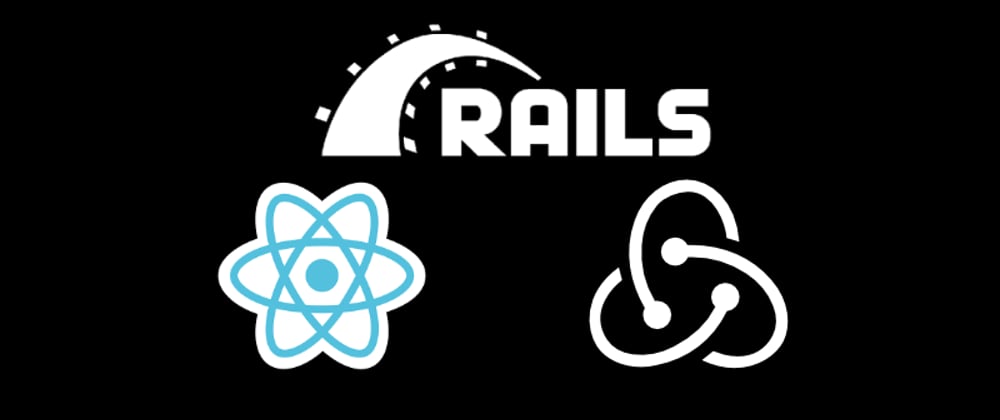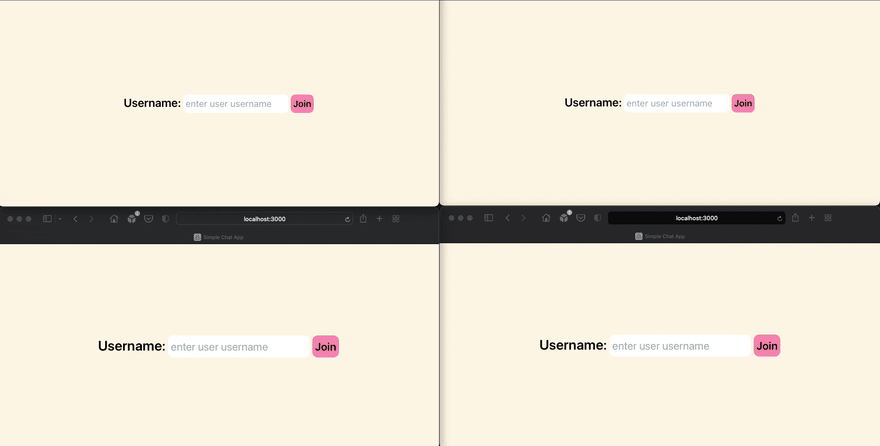Note: all the code for this post can be found here(frontend) and here (backend/rails)
Let's explore how to integrate Rails ActionCable functionality (WebSockets) with a basic chat application using React and Redux (via Redux Toolkit). I'm only including the most relevant snippets of code, please refer to the code in the repo for the entire context.
This is what we will be building:
Backend
Since I'm using rails as an API endpoint, I'll create the app using the --api flag. This will prevent views from being generated when we call any of the rails generate commands, hence avoiding unnecessary code. Additionally, we'll use postgresql as the DB.
rails new chat-app-backend-rails --api -database=postgresql
Since we're building our frontend as a separate standalone project, potentially deployed on a different server than our API, we need to allow for cross domain calls. For that, we first add rack-cors on the Gemfile:
gem 'rack-cors'
And then configure it on config/initializers/cors.rb.
Rails.application.config.middleware.insert_before 0, Rack::Cors do
allow do
# In a prod app you'll restrict to specific origin(s).
# for this will just allow from any.
origins '*'
resource '*',
headers: :any,
methods: %i[get post put patch delete options head]
end
end
We then bundle install to install the gem we added.
Our app will simply have User and Messages. Let's create the models for that:
rails generate model User
rails generate model Message
Our User will only have username and status this is what the migration looks like:
class CreateUsers < ActiveRecord::Migration[7.0]
def change
create_table :users do |t|
t.string :username
t.string :status
t.timestamps
end
end
end
And for the Message:
class CreateMessages < ActiveRecord::Migration[7.0]
def change
create_table :messages do |t|
t.string :content
t.timestamps
end
end
end
Our models have a 1-to-many relationship (1 user has many messages). We'll capture that by adding has_many :messages on the User and belongs_to on Message.
class User < ApplicationRecord
has_many :messages, dependent: :destroy
end
class Message < ApplicationRecord
belongs_to :user
end
Lastly, we'll add a migration that adds the reference (user_id) to messages.
rails generate migration AddBelongToMessages
With this code:
class AddBelongToMessages < ActiveRecord::Migration[7.0]
def change
add_belongs_to :messages, :user
end
end
Note: We could have added this when we first created the Message migration.
Finally, we run the migrate command:
rails db:migrate
Next, let's add all the routes we'll be using and mount the ActionCable (WebSocket) server:
resources :messages, only: %i[index]
resources :users, only: %i[index create] do
post 'add_message'
post 'change_status'
end
mount ActionCable.server => '/cable'
That's it for the setup. We're now ready to start adding some functionality. Let's start creating the messages and users channels. We'll use these to listen for messages posted on the chat and for users joining.
rails generate channel messages
rails generate channel users
In both generated channels, we'll simply change the subscribed method to specify where we're streaming from:
class MessagesChannel < ApplicationCable::Channel
def subscribed
stream_from 'message_channel'
end
def unsubscribed; end
end
class UsersChannel < ApplicationCable::Channel
def subscribed
stream_from 'user_channel'
end
def unsubscribed; end
end
Now we can use the ActionCable.server.broadcast() method to broadcast to all the subscribers on those channels. We want to notify to all subscribers of the user_channel when a user joins the chat. We also want to notify the message_channel after sending messages. Let's do both of those things on the UsersController:
class UsersController < ApplicationController
def index
users = User.all
render json: users
end
def create
user = User.new(user_params)
ActionCable.server.broadcast('user_channel', user) if user.save
render json: user
end
def add_message
user = User.find(params[:user_id])
message = params[:message]
created_message = user.messages.create(content: message)
ActionCable.server.broadcast('message_channel', created_message) if user.save
head :ok
end
def change_status; end
def user_params
params.require(:user).permit(:username, :status)
end
end
For completion, we also have our MessagesController that returns all messages for the users who just joined the chat (that way they can see what was said before them joining).
class MessagesController < ApplicationController
def index
messages = Message.all
render json: messages
end
end
With that, we have all the API calls we need to integrate with our frontend:
rails routes | grep users
user_add_message POST /users/:user_id/add_message(.:format)
user_change_status POST /users/:user_id/change_status(.:format)
users GET /users(.:format)
POST /users(.:format) users#create
rails routes | grep messages
messages GET /messages(.:format)
Frontend
For the frontend, I'll be using react with redux and typescript. Let's create the app:
npx create-react-app chat-app-ui --template redux-typescript
This template will give you an application skeleton that uses redux with toolkit already setup (e.g., a sample reducer, a configured store, etc.).
I'll start by creating a /features/users folder. In there I'll add all the api and reducer functionality. In there I created a usersAPI with all the backend calls related to users. For example, this is how we're adding a new user to the chat:
export const addNewUser = async (user: UserType): Promise<any> => {
const res = await fetch("http://localhost:3090/users", {
method: "POST",
headers: {
"Content-Type": "application/json",
},
body: JSON.stringify(user),
});
return await res.json();
};
And this is how we handle a user sending a message:
export const sendUserMessage = async (
data: sendUserMessageDataType
): Promise<any> => {
const res = await fetch(
`http://localhost:3090/users/${data.user.id}/add_message`,
{
method: "POST",
headers: {
"Content-Type": "application/json",
},
body: JSON.stringify({
user_id: data.user.id,
message: data.message.content,
}),
}
);
return await res.json();
};
We will use these API calls indirectly via Redux thunks.
When working with async calls in the frontend, we usually make the async call and if it succeeds, we update the application state (e.g., Redux state) with the results. With thunks, the process is the same, but all is handled in the reducer itself. We only have to dispatch an action and after is fulfilled (e.g., call succeeded) then we update the state.
This is what a thunk looks like for adding a new user and for sending messages:
...
export const addUserAsync = createAsyncThunk(
'users/addUser',
async (user: UserType) => {
const response = await addNewUser(user);
return response;
}
)
export const sendMessageAsync = createAsyncThunk(
'users/sendMessage',
async (data: sendUserMessageDataType) => {
const response = await sendUserMessage(data);
return response;
}
)
...
We then configure them on the extraReducers section of the createSlice().
...
extraReducers: (builder) => {
builder
.addCase(sendMessageAsync.fulfilled, (state, action) => {
let updatedUser: UserType = state.value.filter(user => user.id === action.payload.user.id)[0];
updatedUser.messages.push(action.payload.message);
state.value = state.value.map(user => user.id !== updatedUser.id ? user : updatedUser)
})
.addCase(addUserAsync.fulfilled, (state, action) => {
state.value.push(action.payload);
localStorage.setItem("currentUser", JSON.stringify(action.payload));
state.userLoggedIn = true;
})
},
...
You can review the entire reducer here.
To call Rails's ActionCable we have to install the actioncable package.
npm install --save actioncable
This is how we're using actioncable in the Messages.tsx to subscribe to new messages posted:
import { useAppDispatch, useAppSelector } from "../app/hooks";
import { addMessage, selectMessages } from "../features/messages/messagesSlice";
import { MessageType } from "../types";
import Message from "./Message";
import ActionCable from "actioncable";
import { useEffect } from "react";
function Messages() {
const messages: MessageType[] = useAppSelector(selectMessages);
const cable = ActionCable.createConsumer("ws://localhost:3090/cable");
const dispatch = useAppDispatch();
const createSubscription = () => {
cable.subscriptions.create(
{ channel: "MessagesChannel" },
{ received: (message) => handleReceivedMessage(message) }
);
};
const handleReceivedMessage = (message: any) => {
dispatch(addMessage(message));
};
useEffect(() => {
createSubscription();
}, []);
return (
<div className="">
{messages.map((message) => (
<Message key={message.id} message={message} />
))}
</div>
);
}
export default Messages;
We use the same approach on the Users.tsx to subscribe to new users joining the chat.
With everything configured and styled, this is what the entire chat application looks like:
With that, we have an app using WebSockets with React, Redux, and Rails.








Top comments (0)